Multiple Monsters
It is worth noting that the idea of increasing the number of trunks was simple, lay on the surface and became one of the first ways to increase the real rate of fire of firearms. In many countries of the world, designers created real multi-barreled monsters who could not replace a modern machine gun or machine gun, but definitely made an impression, at least with their appearance, like an 14 barrel gun created by the English gunsmith William Dupé at the dawn of the XIX century.
William Dupe's 14-Barrel Gun
English gunsmith William Dupé created firearms at the turn of the XIX century, some of his models have survived to this day, you can find sets of dueling pistols of this gunsmith on the Internet. However, the 14-barrel rifle, which today can be seen in the collection of the Museum of Weapons in Liege, is of the greatest interest. It is believed that the master made this unusual copy for the Colonel of the British Army Thomas Thornton around the turn of the 1800-year.
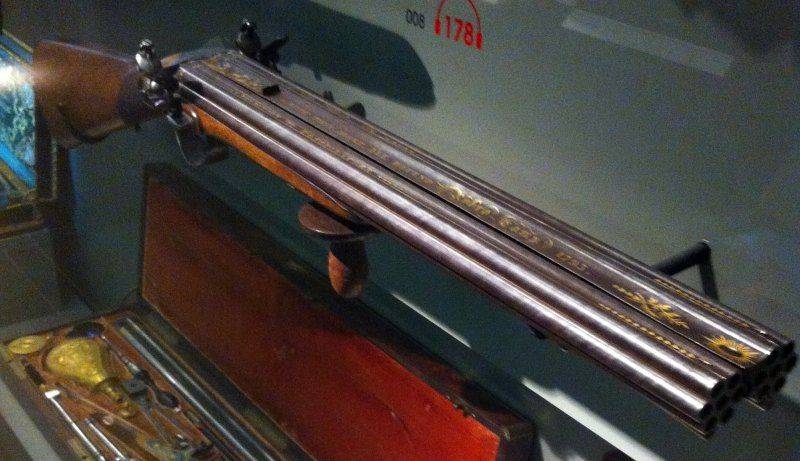
A special feature of the gun was the presence of two blocks of trunks of seven pieces. Each of the 14 trunks had a caliber 12,5 mm. For weapons of the era of the domination of black powder and round bullets caliber was too small. The traditional army guns of those years had a caliber from 15,4 mm, while for serf guns it reached 25 mm. At the same time, a volley of a 14-barreled shotgun could be a powerful argument in any battle or dispute that needed to be resolved with a weapon. Most likely, the shooting from an unusual rifle was carried out with volleys, which made it possible to fire seven bullets per shot at the target. The effect for the enemy was monstrous, as was the expected return at the moment of the shot.
Weapons could hardly be called mobile, given the size and weight, which were supposed to be very impressive. It is difficult to understand for exactly what purposes such a weapon was needed by a colonel of the British army. In battle, weapons could be used only in specific conditions (in defense with strong walls or a suitable stop), it would be madness to hunt with them, if you do not take into account the case when a deer or other forest animals would not run out to the stance the hunter themselves. The original decisions of the gunsmith include the presence of a tactical grip, an advanced solution for its time. Without it, to keep the gun at the time of the shot, apparently, it was simply impossible.
English assault boarding guns
Separately, you can select multi-barrel guns, which were used during boarding fights. We all know the image of a pirate who has entrenched himself in the cinema. The screen character, preparing to attack the enemy ship, is armed with several pistols at once. In a world in which there were no multiply-charged weapons, this was the way out. Another solution was the multi-barrel model of guns, some of them most resembled a sawn-off shotgun.
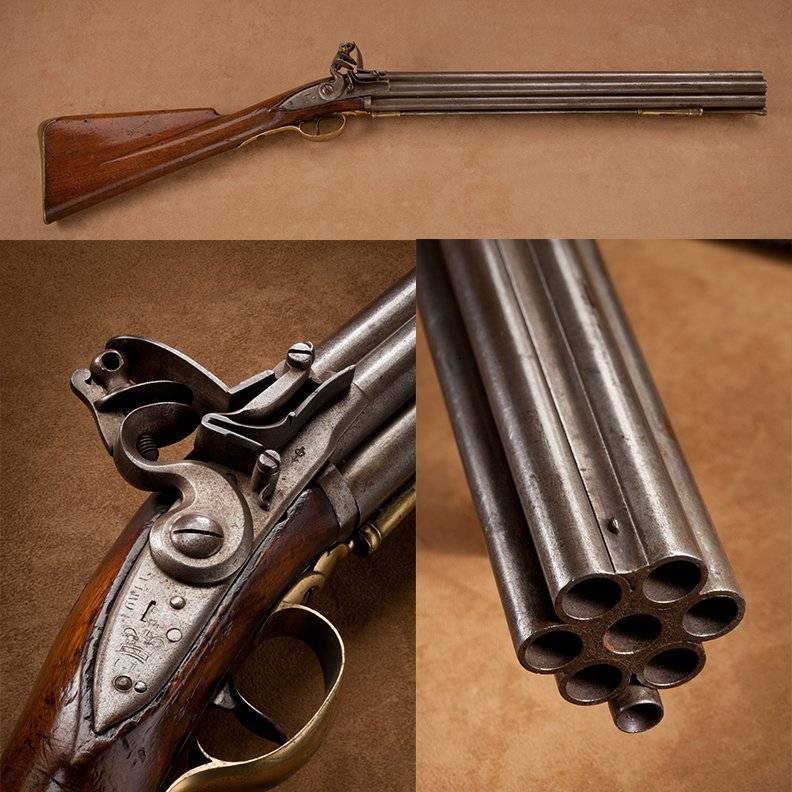
Known models of multi-barreled small arms of the era of the Napoleonic wars include the British naval seven-barreled shotgun. Known weapons received through a series of novels by the writer Bernard Cornwell, telling about the adventures of arrow Sharpe. The model was produced not too large series in the late XVIII - early XIX centuries. The design of the seven-barreled shotgun was developed by James Wilson, but the manufacture was carried out by the manufacturer Henry Nok, who gave his unusual model of firearms his name.
The weapon was a rather heavy (weight over 6 kg) musket with seven trunks and one flint lock. The rifle fired a volley, sending seven 13,2 mm caliber lead bullets at the enemy, the total weight of the volley was 170 grams. Such a volley literally swept opponents from the deck of an enemy ship. With all the shortcomings, to which they attributed not the most outstanding accuracy of shooting and a huge return from the shot, the weapon found its admirers. In a situation where targets hit on the deck of the ship, it was not so important. The disadvantages of weapons also referred to the complexity of the care and the duration of the recharge process, these problems were common to all samples of multi-weapon weapons of those years.
A multi-barreled rifle could be used when boarding an enemy ship, and as a anti-board weapon. There is also a version that an unusual rifle could be used by captains of British ships as a weighty argument when it was necessary to prevent a team’s riot. In any case, the British government bought approximately 600 of similar seven-barreled shotguns for the fleet.
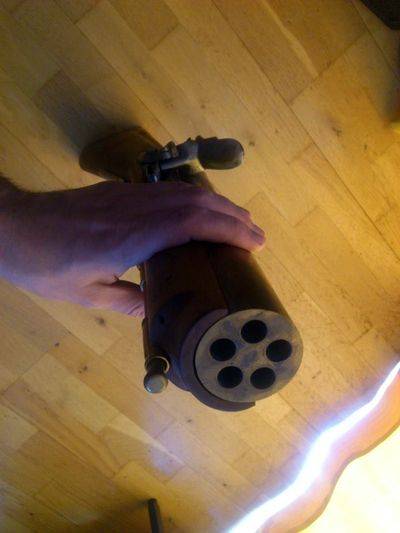
Another sample of such boarding weapons is presented on the blog strangernn.livejournal.com. On the pages of the blog, the author talks about the assault rifle with five barrels. The main materials are wood and bronze. Multi-barreled weapons were made at about the same time frame as William Dupée's unusual 14 barrel gun. At the same time it is technologically easier. All five barrel bores were drilled in a large-sized bronze billet. This is the main difference of the model from previous models, where each trunk was separate.
With a fairly modest size, the mass of the five-barrel assault gun was 5,8 kg. At the same time, the weapon was significantly shorter than Knock's seven-barreled rifle, resembling modern trim. In combat, it was partly more convenient. When boarding fights was enough and a small length of the trunks, it was assumed that the shooter will do a volley almost point blank before jumping onto the deck and begin to fight with the enemy using cold weapons. In this regard, ballistics and accuracy should have been enough, at least one bullet would certainly have found its target.
Multiple PepperBox
Special mention deserve the multi-barreled pistols, which also appeared at the turn of the XVIII - XIX centuries. For them stuck the unusual name "peperboks". When literally translated from English, means "box with pepper" or simply "pepper". At first, the term was widely applied to all multiply-charged pistols, it was even used to designate the first revolvers. But first of all, the word describes a multi-barreled pistols, most of all resembling a revolver externally enlarged in size or a very small Gatling machine gun.
A distinctive feature of such multi-barreled pistols was a rotating block of barrels. PepperBox was charged from the side of the barrel, initially it repeated the process of charging vintage flint pistols, but in the future samples of multi-barrel pistols began to appear more and more resembling revolvers, which also had a folding mechanism in the design, which allowed charging pistols from the breech part. It is believed that the first Pepperboxes were created by designers in the UK and the USA, it happened around the years 1780-1800, after which the pistols quickly spread throughout the world. Their models of PepperBox were created in Russia, but in our country they have never been a priority, and rarely created samples were almost the exact embodiment of foreign analogues.
If we consider the traditional scheme, the Pepperboxes were distinguished by the presence of six trunks of a small length, models with four trunks were also widely distributed, the trunks were screwed into a rotating block. Common in the design were flintlock and the seed shelf. In all the first models of unusual weapons, the barrel block was rotated by the shooter exclusively by hand, it was necessary to do this with gloves, since after the shot the “spent” barrel heated up. Also, the shooter needed to sprinkle a new batch of gunpowder on the shelf each time, which did not increase the efficiency and rate of fire of the Pepperbox, but even in this form the gun found its niche.
At first, the presence of a flintlock significantly reduced the capabilities of multi-barreled pistols. After the appearance of the capsule lock, they found a second life. Proto-revolvers with a new capsule lock (sometimes experts use such a designation for peperboxes) could boast the possibility of continuous shooting. The cross on an unusual family of short-barreled firearms was put by revolvers. Classic revolvers became widespread in the first half of the XIX century, and the invention of Samuel Colt, who improved their design, adding the ability to automatically rotate the drum, finally buried peperboxes.
The idea of multiple weapons in our days
If you think that multi-barrel small arms are a victim of technological progress and are forever lost in the first half of the 19th century, you will be wrong. Samples of multi-barrel weapons were created in the 20th and 21st centuries. In the Soviet Union, on the basis of the TKB-022 PM submachine gun, the designer-gunsmith German Korobov in 1962 created perhaps the most interesting automatic weapon for 7,62-mm caliber cartridges. The designer created a three-barreled automatic machine, which was officially called the 7,62-mm three-barreled device for volley fire, the weapon received the index model 3Б. Three barrels, combined in one machine gun, provided a firing rate crazy for such a weapon - up to 1400-1800 rounds per minute. At the same time, Korobov borrowed some of the structural elements from the legendary Kalashnikov assault rifle, which not only accelerated development, but also significantly simplified the construction of an unusual assault rifle.
It is worth noting that German Korobov did not stop at the 3B model, creating an even more advanced triple-barreled machine, which received the TKB-059 index. Its main difference from its predecessor was the smaller mass-dimensional characteristics; this was achieved due to the processing of certain weapon units and the introduction of new production technologies. The model successfully stood the test, and was the most real military weapons. Moreover, TKB-059 showed excellent accuracy of fire, thanks to the almost simultaneous firing of three rounds in one queue. The disadvantages of weapons attributed the complexity of the equipment cartridges, the specificity of the design, all this, along with the lack of an urgent need to replace the AKM and left the unusual machine in the status of experimental development.
The idea with multi-barreled small arms was not lost in the XXI century. In 2012, at one of the arms exhibitions, Israeli designers of the Silver Shadow company demonstrated to the public their vision of a modern multi-barreled weapon - a double-barreled automatic rifle machine called Gilboa Snake. In fact, this is a modern assault rifle, which can be made in various calibers, the base one - under the NATO cartridge 5,56x45 mm. The Israelis created their model on the basis of a shortened version of the Gilboa Commando assault rifle. The new instance received an extended receiver box, with which the designers combined two barrels parallel to each other at a distance in 30 mm. It is important to understand that this is not a mass sample. The salvo machine was originally developed for the needs of the special forces of the Israel Defense Forces; weapons never claimed the role of a mass armor for conventional infantry units. The presence of such a double-barreled automaton only expands the capabilities of the special forces, allowing it to be used when circumstances and circumstances require it.
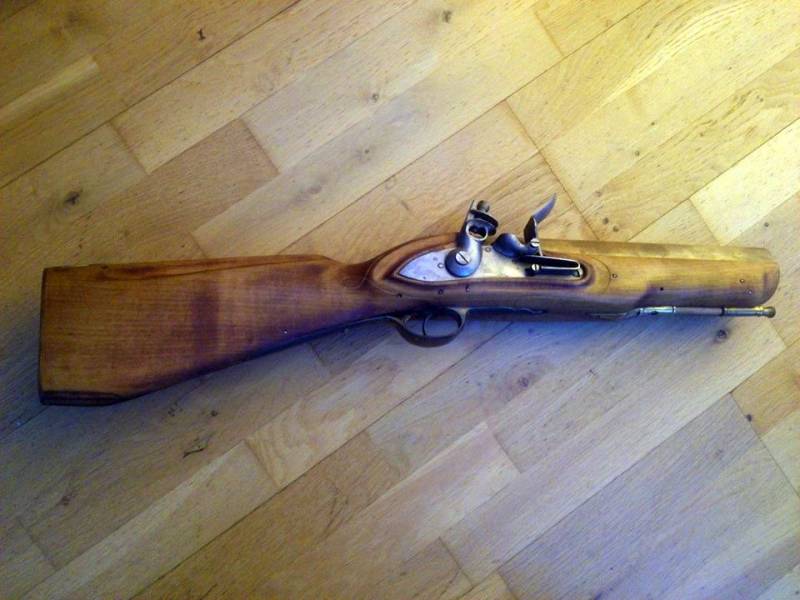
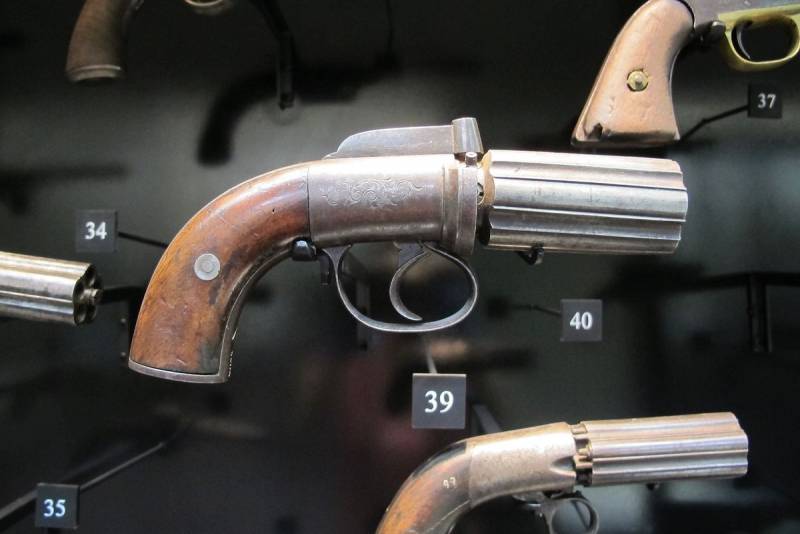
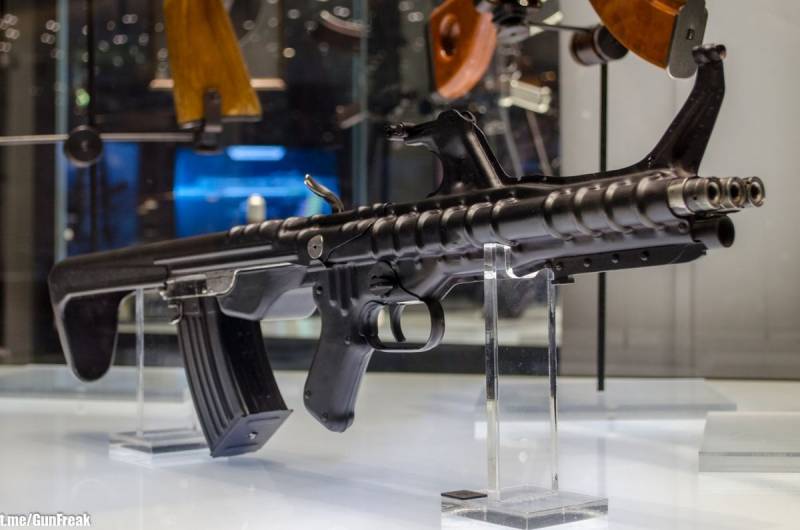
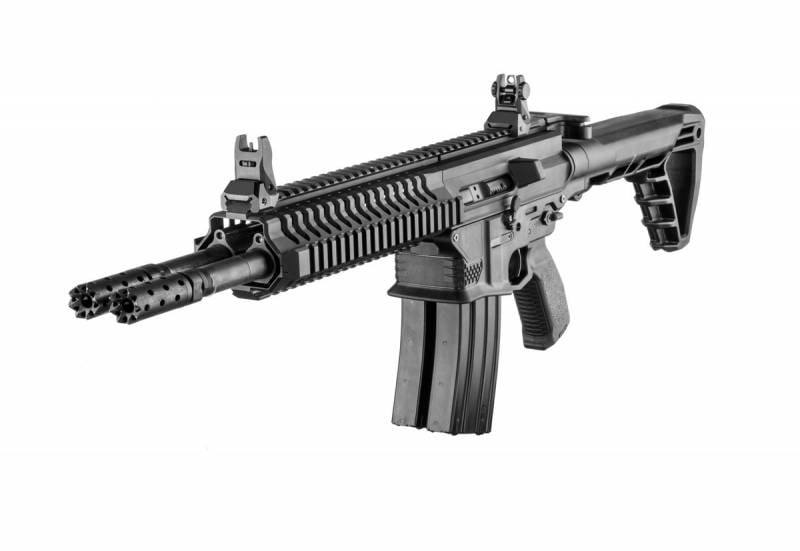
Information